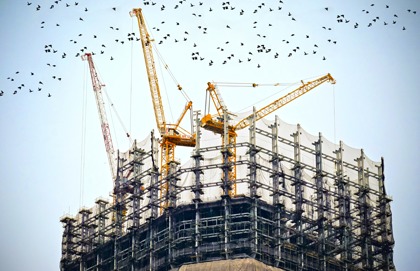We often hear big questions asked about architecture. What worldview shaped that art museum, or this cathedral? Why are those gargoyles there? Why is the McMaster Children's hospital such a brutal, hideous, disgusting piece of grey matter? Did anyone give any thought to the relationship between an ugly building and its effects on healing?
And we hear lots of thoughts too on social architecture; it's what Cardus does. Thinking and building go together.
But it's less common for us to have public discussions, and do broader thinking about the actual, physical construction of these pieces of architecture. In fact, like the thousands of workers who built the great cathedrals, discussion about the nature of work and its meaning sometimes fades into oblivion in public life.
But, like the workers on the cathedrals, just because you don't see or hear them, doesn't mean that the questions aren't there.
Last week I ended a conference that Cardus hosted with a reflection that in discussing the increasingly important role of the construction and resource sectors on the Canadian economy, our conversation at the conference covered topics ranging from shop class to soul craft.
We heard one panelist express his view that labour needs to be considered a commodity and, a moment later, talk about the "soul-crushing" nature of having to stand at the bottom of a scaffold to go up and do the work that you're paid to do. We heard another panelist talk about the frustration that construction workers felt having to break-down and recreate work that was done by someone else, simply because someone along the line in the construction project didn't consider the hard physical facts of size and shipping. And, in the same breadth, we heard about the dogged determination to do the job right, even if someone else screwed up.
In other words, a conversation that began talking about broad trends in Canada's economic life went from aggregate capital investment to questions of the nature of work, and then back again.
That is how it should be. The economy and work are not things that simply "exist." They necessarily reflect deeper questions about what it means to be human. The question of something as broad as investment, or the net effects of labour unions on wages or industrial competitiveness cannot be divorced from questions of justice. Collective agreements or individual employment contracts are never just about wages, pension and benefits. And the same is true for investment. These things inevitably, even if unreflectively, derive from our desires, and from deeper questions about the relation of work to personal identity, of the individual to the community, of justice, of happiness. And it reflects complex questions about how multiple individuals, institutions, and organizations interact.
Every strike of the hammer, every turn of the wrench, every connection of wires is a response to these deeper questions. Like a tradesperson eyes up the day's work, it's worth spending some time thinking about them.







